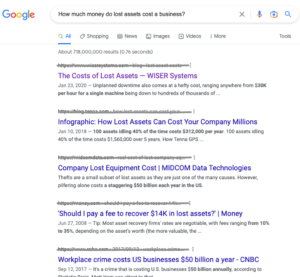The Cost of Lost Assets Toolkit

We’ve all lost something important we took for granted until it was gone. Companies, too, understand their assets and how they are vital to the business mission, but few business leaders consider the cost of lost and mismanaged assets – until it happens.
How can your business ease unexpected asset loss?
Getting the business started
Nearly half of all U.S. businesses track their business assets ineffectively. Most start with some manual process like spreadsheet management or even no asset tracking process at all.
But growing a small business with spreadsheet asset management eventually becomes frustrating and inefficient. The cost and lost revenues associated with searching for and replacing missing assets are so high that companies began using systems like barcode, Q.R., and RFID (Radio Frequency Identification) to track assets.
Now that the systems and capabilities are here, asset tracking has become a top priority across industries in businesses of all sizes.
A company for growth
As your company continues to grow in an expanding marketplace, the time will come when you’ll have to truly consider your company’s assets and how you’ll manage them.
Spreadsheet tracking and other manual methods you use to assess the financial impact of missing tools and equipment are inadequate today. We know this because it happens to every business once it reaches a certain point.
A complete asset tracking solution is the answer to these ineffective methods of controlling the costs of lost assets.
How much money do lost assets cost a business?
Lost equipment isn’t just frustrating; it’s outright expensive. But it’s a complex number to nail down for many reasons. Many lost assets are never tracked or measured, and it can be challenging to determine the indirect costs of the missing asset.
However, a simple web search will return the following:
“100 assets idling 40% of the time costs $312,000 per year. 100 assets idling 40% of the time costs $1,560,000 over 5 years.”
“Unplanned downtime also comes at a hefty cost, ranging anywhere from $30K per hour for a single machine being down to hundreds of thousands…”
“…pilfering alone costs a staggering $50 billion each year in the U.S.”

Calculating the financial impact of your company’s asset loss is made more challenging by ghost assets on the books and lost hours of productivity spent locating missing tools
Not with asset tracking software
The costs of loss assets are preventable with the right strategy, process, and technologies in place. Asset tracking software helps you determine how much missing, damaged, expired, or stolen assets can cost your business.
By making your business more efficient and saving you money, an asset management solution can help your business grow.
Increasing productivity with asset management software
Manual tracking processes often miss the assets that move between departments or locations. Then how would you determine how many assets you have, where they are, how many need repair?
Without asset tracking software, data silos between departments force employees to search for unaccounted-for items. Asset recovery processes become more time-consuming and destroy productivity.
Reducing these inefficiencies increases productivity. Instead of looking for tools and equipment, your staff has more time to spend on essential tasks that save money and resources.
Saving money with asset management software
You can better plan your budget by knowing when scheduled maintenance occurs so you can allocate the appropriate funds for replacements.
Asset tracking software reduces theft which helps protect your investment. Then as your business grows, negligent asset tracking can lead to unnecessary spending by allowing you to purchase assets you already own.
Growing your business with asset management software
By tracking your assets properly, you’re able to develop a system of streamlined workflows based on functioning equipment with high productivity and efficiency. This allows you to scale your business faster and reach your goals on schedule.
Asset tracking software decreases costs and increases cash flow to be able to implement strategies that increase customer value. Tracking asset status like receivable updates, asset orders, and status updates allows you to organize assets strategically to ensure proper utilization of resources.
Ease of accessibility of business asset information saves time on decision-making processes that inspire growth.
When to consider asset management software for your business
Asset management software will help you control your business costs by ensuring you utilize every asset you procure and keep it and your employees accountable.
While spreadsheets have been the most user-friendly and reliable asset management tools for decades, the technology is outdated for managing and tracking today’s business assets.
Apart from improving the accuracy of your asset record, asset management software streamlines your business processes and generates revenue to ensure you continuously grow and scale your business. Also, asset-tracking software reduces the risk of compliance issues that often occur due to human errors in laborious manual processes of asset management. Automatically sharing compliance reports with your customers strengthens customer relationships and build loyalty.
Every business that relies on tools and equipment needs asset management software. Contact one of our asset specialists to learn more about how you can get the most out of your assets with Anytime Assets.
